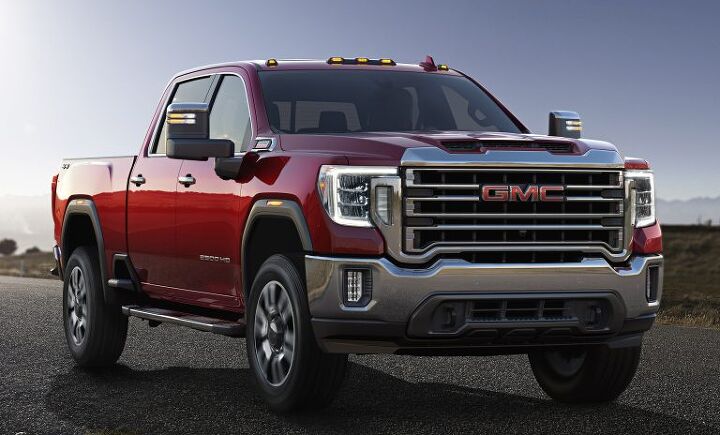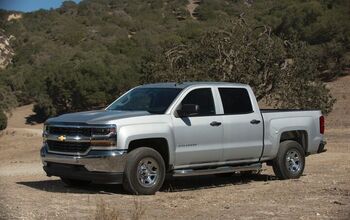General Motors Halts Pickup Truck Production Again

It’s no surprise that automotive computer chips are harder to find than potato chips at a Beachbody convention. GM has been hit hard by the shortage, forced to idle production of its most profitable machines while choosing to de-content some of their vehicles in a bid to keep the lines humming.
Truck production will take another hit this week, with a trio of pickup plants scheduled to fall silent for seven days starting on August 9th.
According to a report by the Detroit News, The General confirmed yesterday that their Heavy Duty plant in Flint, plus the light-duty outfits in Mexico and Indiana, will go offline this coming Monday. The company figures a week’s break will ease the situation and plans to have the place rocking again within a week but that timeline could change – for better or worse – depending on what is an increasingly fluid situation.
And, before you ask, this is a different shutdown than the one on which we reported earlier. Monday’s action will mark the second time GM truck production has halted thanks to a shortage of semiconductors, though the HD facility in Flint did manage to retain one shift during that hiccup. That will not be the case this time around.
Barren dealer lots should be familiar to most of our readers by this point in the calendar year 2021, and the following list of temporarily shuttered GM factories should explain why. In addition to the truck stoppage mentioned above, facilities at Spring Hill, Lansing, CAMI (Canada) Ramos (Mexico), and San Luis (Mexico) have all been down since July 19. The crew in Tennessee is not scheduled to restart until Monday, Lansing resumes on August 16th, while San Luis and CAMI shutdowns could potentially stretch into September. All those plants assemble money-making crossovers and SUVs, the type consumers typically snap up by the yaffle during normal times. Models include – among others – the XT4/XT5, Acadia, Equinox, and Terrain.
Alert readers will recall that, in a bid to keep a trickle of trucks flowing to hungry dealers, GM ceased including some chip-driven features such as start/stop and Dynamic Fuel Management. Your author recently spent a week in a GMC Sierra powered by a 5.3L V8 that was affected by these changes and can report that fuel economy did take a small hit compared to equivalent testing in an equally-optioned truck last year. Overall performance while towing a heavy trailer was unaffected, as you’d likely expect.
GM is hardly alone in this boat, with plenty of other manufacturers dealing with production challenges of their own. The global chip shortage is said to have stemmed from the pandemic’s early days, in which car production waned by demand for electronics by house-bound humans skyrocketed. Chip suppliers, then directed their flow of product in that direction, a blip that has yet to smooth out in the favor of automakers.
[Images: GMC]

Matthew buys, sells, fixes, & races cars. As a human index of auto & auction knowledge, he is fond of making money and offering loud opinions.
More by Matthew Guy
Latest Car Reviews
Read moreLatest Product Reviews
Read moreRecent Comments
- El Kevarino There are already cheap EV's available. They're called "used cars". You can get a lightly used Kia Niro EV, which is a perfectly functional hatchback with lots of features, 230mi of range, and real buttons for around $20k. It won't solve the charging infrastructure problem, but if you can charge at home or work it can get you from A to B with a very low cost per mile.
- Kjhkjlhkjhkljh kljhjkhjklhkjh haaaaaaaaaaahahahahahahahaha
- Kjhkjlhkjhkljh kljhjkhjklhkjh *Why would anyone buy this* when the 2025 RamCharger is right around the corner, *faster* with vastly *better mpg* and stupid amounts of torque using a proven engine layout and motivation drive in use since 1920.
- Kjhkjlhkjhkljh kljhjkhjklhkjh I hate this soooooooo much. but the 2025 RAMCHARGER is the CORRECT bridge for people to go electric. I hate dodge (thanks for making me buy 2 replacement 46RH's) .. but the ramcharger's electric drive layout is *vastly* superior to a full electric car in dense populous areas where charging is difficult and where moron luddite science hating trumpers sabotage charges or block them.If Toyota had a tundra in the same config i'd plop 75k cash down today and burn my pos chevy in the dealer parking lot
- Kjhkjlhkjhkljh kljhjkhjklhkjh I own my house 100% paid for at age 52. the answer is still NO.-28k (realistically) would take 8 years to offset my gas truck even with its constant repair bills (thanks chevy)-Still takes too long to charge UNTIL solidsate batteries are a thing and 80% in 15 minutes becomes a reality (for ME anyways, i get others are willing to wait)For the rest of the market, especially people in dense cityscape, apartments dens rentals it just isnt feasible yet IMO.



































Comments
Join the conversation
@Matthew--I would be interested in a follow up on Ford on the chip shortage. I read on Ford Authority that the chip shortage could last thru June of 2022. I would be interested in how this will effect the production of the new Maverick which at the latest Ford scheduled to start production on August 16. I was told by the Ford dealership that it could be as late as next Spring until I get the Maverick that I ordered. I will hold onto my 2008 Ranger until I get the Maverick.
If the chip shortage persists the manufacturers might go more to the consumer placing orders for new vehicles. Ford lets you select your vehicle on their website and then you get a email notification and call by the dealer. If this becomes permanent the dealers can reduce the size of their locations with less space to park inventory and less showroom space.